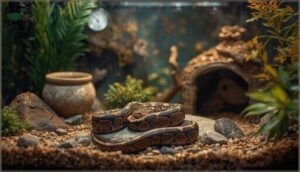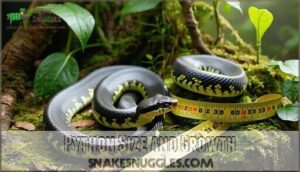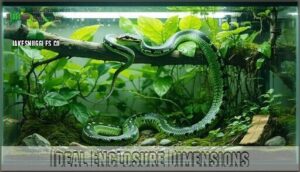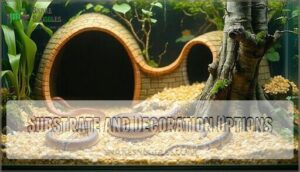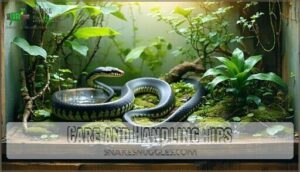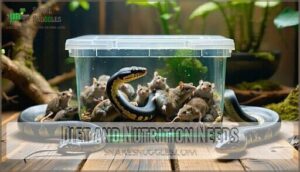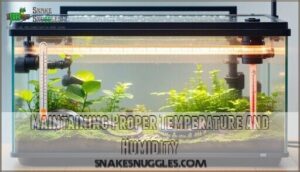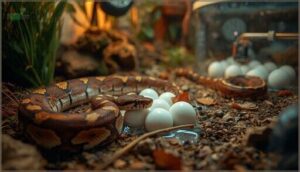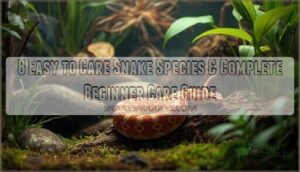This site is supported by our readers. We may earn a commission, at no cost to you, if you purchase through links.
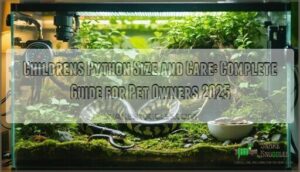
You’ll need a minimum 40-gallon tank with temperatures between 78-88°F and humidity around 50-60%.
Their calm temperament and manageable size make them perfect for first-time snake owners who want a reptile that won’t outgrow their space or their comfort zone.
These docile Australian natives live 20+ years with proper care, and they’re escape artists, so secure enclosures are essential.
Feed juveniles weekly and adults every 2-3 weeks with appropriately-sized frozen-thawed rodents, and understand that the secret to thriving children’s pythons lies in understanding their specific environmental needs, which is crucial for their well-being and requires a proper care approach.
Table Of Contents
- Key Takeaways
- Childrens Python Overview
- Python Size and Growth
- Enclosure Size Requirements
- Care and Handling Tips
- Top 8 Products for Childrens Pythons
- 1. Large reptile glass terrarium tank
- 2. Forest Floor Reptile Bedding Substrate
- 3. Reptile Heating Pad Thermostat Combo
- 4. Reptile Infrared Heat Emitter Bulb
- 5. Reptisun Led Terrarium Lighting Hood
- 6. Reptile Terrarium Heat Lighting Timer
- 7. Reptile Terrarium Fogger Humidifier System
- 8. Natural Green Sphagnum Moss Terrarium
- Health and Wellness Concerns
- Diet and Nutrition Needs
- Habitat and Environment Setup
- Breeding and Reproduction
- Long Term Care Commitment
- Frequently Asked Questions (FAQs)
- What size enclosure for a children’s python?
- How big of a tank do you need for a children’s python?
- Do children’s pythons like to be held?
- How big do children’s pythons get?
- Can childrens pythons be housed together safely?
- Whats the difference between males and females?
- How often do childrens pythons shed skin?
- Do they need special lighting or UVB?
- What permits are required for ownership?
- Conclusion
Key Takeaways
- You’ll need a minimum 40-gallon tank for adult Children’s pythons, as they grow to 3-4 feet long and need proper space for their semi-arboreal climbing behavior.
- Maintain precise environmental conditions with temperatures between 78-88°F, humidity at 50-60%, and secure enclosures since these snakes are notorious escape artists.
- Feed juveniles weekly and adults every 2-3 weeks with appropriately-sized frozen-thawed rodents that equal 10-15% of your snake’s body weight to prevent obesity.
- Prepare for a 20-30 year commitment with these docile, low-maintenance pythons that make excellent beginner pets but require consistent care throughout their long lifespan.
Childrens Python Overview
You’ll find that Children’s pythons (Antaresia childreni) are Australia’s smallest python species, making them perfect beginner reptiles with their calm temperament and manageable 3-4 foot adult size.
These hardy snakes from northern Australia can live up to 30 years in captivity, so you’re looking at a long-term companion that’s surprisingly low-maintenance compared to larger python species, which is a significant factor to consider when choosing a pet.
Scientific Name and Origin
Your Childrens Python belongs to the species Antaresia childreni, named after British Museum curator John George Children who discovered them in the 1800s.
These Australian snakes originate from Northern Australia’s diverse habitats.
Don’t worry—despite the name, they’re called "Children’s" pythons after their discoverer, not because they’re suitable pets for kids or eat children! The name is often misunderstood, but it refers to the discoverer.
Physical Characteristics and Appearance
Your Antaresia childreni displays a slender build with reddish-brown skin shades and distinctive darker markings. These leaf-like patterns create visual interest as your python moves.
Your snake’s graceful movement showcases nature’s artistry in every scale and pattern.
Body length typically reaches 3-4 feet, making size management easier than larger species.
Key physical features include:
- Color patterns that fade from bright juvenile hues to mature earth tones
- Scale texture that’s smooth and glossy throughout their lifespan
- Markings shape resembling scattered leaves along their spine
The python size chart shows consistent growth, with hatchlings measuring under 12 inches.
Lifespan and Temperament
Your children’s python will live 20-30 years in captivity, making it a long-term companion that’ll outlast many family pets.
These docile snakes rarely bite and display calm temperaments, though juveniles can be nippy before mellowing with age.
Their relaxed nature makes python care straightforward for beginners.
| Life Stage | Temperament Types | Behavior Patterns | Health Issues |
|---|---|---|---|
| Hatchling | Defensive, nippy | Active, skittish | Respiratory infections |
| Juvenile | Calming, curious | Semi-arboreal climbing | Feeding refusal |
| Adult | Docile, handleable | Nocturnal activity | Age related obesity |
| Senior | Mellow, predictable | Reduced movement | Longevity factors decline |
The life stages of a python, from hatchling to senior, each present unique characteristics and challenges, including specific health issues and behavior patterns.
Python Size and Growth
Understanding your Children’s Python’s size helps you plan proper housing and care from day one.
These compact pythons reach 3-4 feet as adults, making them ideal for keepers who want a manageable snake without sacrificing the python experience, which is a key aspect of the python experience.
Average Length and Weight
Your python’s size can vary like fingerprints – each snake is unique.
Adult Children’s pythons typically reach 3-4 feet in length, making them perfect for beginners who want a manageable pet.
- Snake Length: Most adults measure 90-120 cm (3-4 feet) when fully grown
- Weight Factors: Healthy adults weigh between 200-400 grams depending on body condition
- Growth Rates: Juveniles reach adult size within 12-18 months with proper care
- Size Variations: Females often grow slightly larger than males in this species
- Python Measurements: Hatchlings start under 30 cm and triple their length quickly
Factors Affecting Growth Rate
Growth rate depends on several interconnected factors.
Genetic Factors determine your python’s maximum size potential, while Nutrition Impact from proper feeding schedules affects development speed.
Environmental Influence through temperature and humidity controls metabolism, and Health Effects from parasites or illness slow growth substantially.
Understanding the python care basics is vital for healthy growth and health.
| Factor | Positive Impact | Negative Impact |
|---|---|---|
| Nutrition | Regular feeding, proper prey size | Overfeeding, underfeeding |
| Environment | Stable temps 78-88°F, 50-60% humidity | Temperature swings, poor conditions |
| Health | Parasite-free, regular vet care | Mites, respiratory infections |
| Genetics | Good breeding lines | Poor genetics, stunted growth |
Size Comparison to Other Pythons
When you place your children’s python next to other species, the size difference becomes striking. Your 3-4 foot companion looks petite compared to giants in the python family.
- Ball pythons typically match your children’s python at 3-4 feet, making them similar-sized cousins
- Carpet pythons dwarf yours at 8 feet, requiring substantially larger enclosures and stronger handling confidence
- Reticulated pythons reach massive 20+ foot lengths, turning feeding into a two-person job with serious space requirements
- Burmese pythons stretch beyond 16 feet, making your children’s python look like a garden snake in comparison
Understanding the python size comparison is vital for python care needs to guarantee proper housing and feeding.
Enclosure Size Requirements
Your Children’s Python needs proper housing space to thrive, with specific minimum requirements that differ substantially from larger python species.
The right enclosure size directly impacts your snake’s health, stress levels, and overall well-being throughout its 20-30 year lifespan.
Minimum Tank Size Recommendations
The right tank size prevents stress and promotes healthy development in your pet snake.
For hatchlings, start with a 20-gallon long tank, then upgrade to a 40-gallon minimum for adults.
Tank size guidelines recommend 36x18x18 inches as baseline enclosure dimensions, though larger is always better.
Space requirements include proper ventilation needs and adequate habitat depth for natural behaviors.
Understanding vital reptile tank sizes is essential for creating a suitable environment with proper ventilation needs and natural behaviors.
Ideal Enclosure Dimensions
While minimum space gets your python settled, ideal dimensions create room for natural behaviors.
A 48x24x24 inch enclosure accommodates adult climbing instincts perfectly, and tank materials like glass or PVC work well, supporting proper heating options and ventilation systems.
This python habitat setup encourages exploration while maintaining humidity control throughout your snake enclosure size.
Proper enclosure size calculations are essential to guarantee the well-being of your pet python.
Substrate and Decoration Options
Choose substrate options that balance safety and functionality for your python.
Aspen shavings, cypress mulch substrate, and coconut fiber create excellent foundations, while avoiding toxic cedar or pine.
Add hide boxes on both warm and cool sides, plus climbing branches to mimic natural python environments.
This tank layout supports proper humidity control and enclosure enrichment.
Proper reptile substrate selection involves considering reptile care to guarantee a healthy environment.
Care and Handling Tips
Proper care guarantees your Children’s Python thrives for decades while remaining a calm, manageable pet.
You’ll need to master three key areas: maintaining precise temperature and humidity levels, following species-specific feeding schedules, and using gentle handling techniques that build trust.
Temperature and Humidity Requirements
Throughout their lives, children’s pythons need precise temperature and humidity control for ideal health.
Create a temperature gradient with basking temps at 88-90°F and cool zones at 80°F.
Maintain humidity between 45-60%, increasing to 70% during shedding periods.
Use heating methods like under-tank heaters with thermostats.
Monitor seasonal adjustments and provide humid hides for proper shedding humidity.
Feeding and Nutrition Guidelines
Proper childrens python feeding involves understanding prey size, feeding frequency, and food safety.
You’ll need frozen rodents that match your snake’s requirements for ideal health.
- Prey Size: Feed rodents 10-15% of your python’s body weight
- Feeding Frequency: Juveniles eat weekly, adults every 10-14 days
- Frozen Rodents: Use frozen-thawed mice or rats, never live feeding
- Supplementation: Occasional calcium dusting supports bone health
- Thawing: Warm prey to room temperature before offering
Proper reptile nutrition care tips, including reptile dietary needs, are essential for maintaining a healthy pet.
Handling and Socialization Techniques
Handle your Children’s python with confident, gentle movements to build trust and reduce stress.
Support their body weight fully during snake handling sessions, avoiding sudden motions that trigger defensive responses.
Regular calm interaction creates positive association between you and your snake.
Start with brief supervised exploration periods, gradually extending taming sessions as your python becomes comfortable with human contact.
Top 8 Products for Childrens Pythons
You’ll need the right equipment to create a proper habitat that keeps your Children’s Python healthy and comfortable.
These eight essential products cover everything from housing and heating to humidity control, ensuring your snake thrives in captivity.
1. Large reptile glass terrarium tank
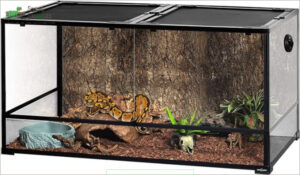
A premium glass terrarium tank transforms your python’s living space into a professional-grade habitat.
You’ll want the REPTI ZOO 120-gallon model (48"x24"x24") with its tempered glass construction and front-sliding doors for easy access.
The larger-woven screen top maximizes UVB penetration while the waterproof base handles bioactive setups perfectly.
This investment gives your Children’s python room to stretch, climb, and thrive for decades.
Best For: Serious reptile keepers who want a safe, spacious, and professional-grade enclosure for adult Children’s pythons or similar reptiles.
- Large and heavy; assembly may require two people and tools.
- Occasional issues with shipping damage and missing instructions.
- Sliding doors lack built-in handles for convenience.
- Large 120-gallon size meets and exceeds space needs for adult pythons.
- Tempered glass and front-sliding doors ensure durability and easy access.
- Enhanced UVB penetration and ventilation promote a healthy habitat.
2. Forest Floor Reptile Bedding Substrate
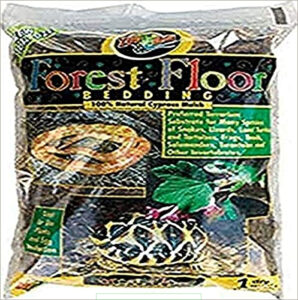
When you’re searching for the perfect bedding, Zoo Med’s Forest Floor Cypress Mulch delivers everything your children’s python needs.
This natural substrate retains moisture beautifully, helping maintain the 50-60% humidity levels these Australian natives crave.
You’ll love how it mimics their forest floor habitat while making shedding easier.
The 9-pound bag provides excellent value, and it’s safe for all life stages.
Just remember to monitor moisture levels and replace regularly to keep your snake’s home fresh and healthy, ensuring a natural substrate that is always safe.
Best For: Owners of children’s pythons and other reptiles or amphibians needing a natural, moisture-retaining substrate that supports healthy humidity.
- Holds moisture well to maintain optimal humidity levels for snakes and amphibians
- Mimics a real forest floor, encouraging natural burrowing and climbing behaviors
- Safe for all life stages and easy to maintain
- Needs regular replacement to avoid mold and keep the tank clean
- Must monitor moisture to prevent excess dampness or mildew
- Not suitable for outdoor use or very arid species
3. Reptile Heating Pad Thermostat Combo
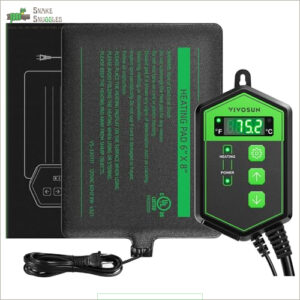
You’ll need a reliable heat source to maintain the temperature gradient your children’s python requires for proper digestion and thermoregulation.
A heating pad thermostat combo provides consistent, controllable warmth without the guesswork, ensuring your snake stays comfortable while preventing dangerous overheating.
These units typically feature digital displays with precise temperature control up to 104°F, and the IP67-rated surfaces clean easily.
The far-infrared technology distributes heat evenly across the enclosure floor for ideal thermal regulation, and this ensures your snake’s environment is well-regulated for its needs.
Best For: Owners of children’s pythons who need reliable, adjustable heating to maintain safe and healthy enclosure temperatures.
- Adhesive may lose effectiveness over time, especially in humid conditions.
- Some users report thermostat accuracy and display issues with frequent use.
- Not ideal for enclosures where strong, permanent adhesion is required.
- Digital thermostat allows precise temperature control and consistent heating.
- Far-infrared technology delivers even warmth across the enclosure.
- Easy-to-clean, water-tight, and flexible design suitable for various setups.
4. Reptile Infrared Heat Emitter Bulb
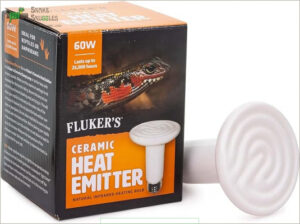
Your python’s nighttime comfort depends on infrared heat emitters that deliver consistent warmth without disrupting sleep cycles.
These ceramic bulbs produce deep-penetrating heat that mimics natural sunlight, supporting healthy metabolism and thermoregulation.
Unlike red bulbs that interfere with circadian rhythms, infrared emitters maintain darkness while creating essential temperature gradients.
You’ll appreciate their durability and 24/7 operation capability, and they’re particularly effective in high-humidity environments where your python thrives, so mount them overhead at proper distances to prevent overheating, and pair with thermostats for precise control.
Best For: Reptile or amphibian owners seeking a reliable, light-free heat source for maintaining natural day/night cycles, especially in high humidity enclosures.
- Requires careful placement to prevent overheating, especially in small spaces
- Needs a thermostat for precise temperature control
- Not an instant heat source; gradual warmth may not suit all setups
- Provides deep, consistent heat without emitting disruptive light
- Durable for continuous 24/7 use, ideal for long-term reptile care
- Safe for sensitive species, effective in creating natural basking gradients
5. Reptisun Led Terrarium Lighting Hood

Bright LED panels transform your python’s habitat into a naturalistic paradise.
The Zoo Med Reptisun LED Terrarium Hood delivers energy-efficient 6500K daylight illumination that mimics natural sunlight perfectly.
You’ll appreciate the modular design – replacing LED panels is effortless when needed.
Red LEDs promote live plant growth while blue LEDs create stunning nighttime effects.
The adjustable rails fit tanks from 18-26 inches, and the thin profile generates minimal heat.
Though it doesn’t produce UVB radiation, you can easily add UVB bulbs for complete lighting coverage.
Best For: Owners of reptiles and amphibians who need bright, natural lighting for tanks between 18 and 26 inches, especially if they want modular, plant-friendly illumination.
- Modular design allows for easy replacement and customization of LED panels
- Energy-efficient, bright 6500K daylight LEDs that support plant and animal health
- Minimal heat output and thin profile, making it safe for sensitive species
- Does not provide UVB lighting and requires added UVB bulbs for full reptile care
- Single switch for red/white and white LEDs may be inconvenient
- Flimsy legs when fully extended and not waterproof
6. Reptile Terrarium Heat Lighting Timer
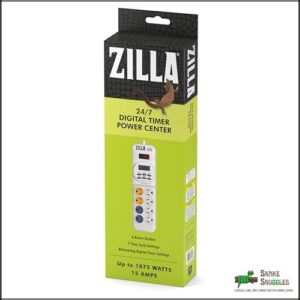
Since maintaining proper day/night cycles is vital for your python’s health, a reliable timer becomes essential equipment.
The Digital Reptile Habitat Lighting Power Center by Zilla offers eight outlets with programmable scheduling—four for alternating day/night heating and four for constant power.
You’ll appreciate its 24/7 digital programming and backup battery that preserves settings during outages.
Set your heating elements to run 12-hour cycles, maintaining daytime temperatures around 84-89°F and nighttime drops to 68-72°F for ideal thermoregulation.
Best For: Reptile owners who need reliable, programmable control of day/night lighting and heating cycles for species like pythons, geckos, or turtles.
- Short 3-foot power cord may limit placement options.
- Sensitive to surges and static electricity, causing occasional resets.
- Initial programming can be confusing for new users.
- Centralizes control of multiple lights and heaters with customizable 24/7 scheduling.
- Backup battery maintains timer settings during power outages.
- Versatile outlets support various heating and lighting devices for flexible setup.
7. Reptile Terrarium Fogger Humidifier System
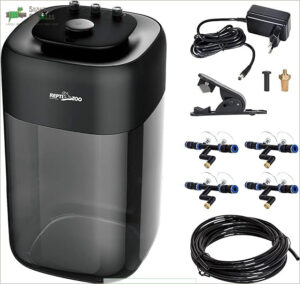
When maintaining proper humidity levels becomes essential for your python’s health, a reptile terrarium fogger humidifier system delivers consistent moisture control.
These ultrasonic units typically hold 2.5-3.5 liters and feature adjustable fog output with automatic timers.
You’ll maintain that sweet spot of 50-60% humidity without over-saturating substrate, and the silent operation won’t disturb your snake’s natural rhythms.
Position the fogger strategically and clean it regularly to prevent mold buildup, making it a set-and-forget solution for ideal terrarium conditions.
Best For: Reptile owners or hobbyists who want consistent, low-stress humidity control for python enclosures and value quiet, automated operation.
- Reports of flooding or water accumulation if not carefully set up
- Timer and manual functions may malfunction after initial use
- Requires regular cleaning and thoughtful nozzle placement to avoid contamination and inefficiency
- Integrated design with a large water tank and no assembly required
- Super silent pump and wide, adjustable spray nozzles
- Effective for maintaining stable humidity and mimicking natural habitats
8. Natural Green Sphagnum Moss Terrarium
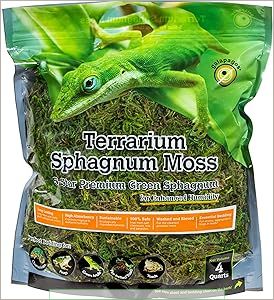
Moisture management becomes effortless when you incorporate natural sphagnum moss into your children’s python setup.
This long-fiber substrate holds water like a sponge, creating those essential humid microclimates your snake needs for successful shedding.
You’ll find it particularly valuable in hide boxes, where it maintains 60-70% humidity while staying mold-free.
The moss breaks apart easily for custom terrarium designs and keeps its vibrant green color for months.
It’s sustainably sourced and washed clean, making it safe for direct contact with your python, and provides an ideal environment for your snake with its ability to hold water like a sponge, creating essential humid microclimates.
Best For: Reptile and amphibian keepers looking to maintain humidity for species like children’s pythons, geckos, frogs, and hermit crabs.
- Holds moisture effectively, supporting healthy shedding and humidity.
- Breaks apart easily for custom terrarium setups and keeps its color for months.
- Sustainably sourced, thoroughly cleaned, and safe for direct contact with pets.
- Requires daily misting to maintain optimal moisture levels.
- Large enclosures may need multiple bags for full coverage.
- Some batches may have variability in quality.
Health and Wellness Concerns
Keeping your children’s python healthy requires understanding common issues that can affect these hardy snakes throughout their 20-30 year lifespan.
You’ll want to watch for early warning signs like respiratory infections, mites, and shedding problems that can quickly become serious without proper intervention.
Common Health Issues and Symptoms
Your python’s health can shift quickly when problems arise.
Respiratory infections show through wheezing, clicking sounds, and open-mouth breathing.
Snake mites appear as tiny black dots near the eyes, causing excessive soaking behavior.
Dysecdysis means stuck shed from low humidity.
Scale rot creates dark, mushy patches on belly scales.
Mouth rot causes swelling and bleeding gums.
Prevention and Treatment Options
Keep your python healthy by staying ahead of problems rather than reacting to them.
Disease Prevention starts with proper quarantine protocols for new snakes and regular Health Screening by experienced reptile veterinarians.
- Parasite Control: Schedule fecal exams every 6-12 months to catch internal parasites early
- Environmental management: Maintain proper humidity and temperature to prevent respiratory infection and scale rot
- Wound Care: Clean minor injuries with diluted betadine solution and monitor healing progress
- Snake mites prevention: Quarantine new animals and inspect regularly for tiny black dots near eyes
- Infection Treatment: Address mouth rot immediately with veterinary-prescribed antibiotics before it spreads
Importance of Regular Veterinary Check-ups
Regular veterinary care serves as your python’s lifeline against hidden health threats.
Schedule annual checkups with reptile-specialized veterinarians for thorough snake health monitoring, parasite control, and dietary advice.
These medical checkups can catch respiratory infections, snake health issues, and nutritional deficiencies before they become serious problems.
Professional veterinary care guarantees your pet reptiles receive expert evaluation beyond basic home observation, ensuring they receive the best possible care against hidden health threats and snake health issues.
Diet and Nutrition Needs
Your Children’s Python’s diet is surprisingly simple – these compact snakes thrive on a straightforward menu of appropriately-sized rodents.
Getting the feeding schedule and portion sizes right will keep your python healthy and prevent the obesity issues that plague many captive snakes.
Feeding Frequency and Prey Size
When establishing your snake feeding schedule, juvenile Children’s pythons need meals every 5-7 days, while adults eat every 10-14 days.
Choose prey that’s roughly 10% of your snake’s weight – pinky mice for babies, adult mice or small rats for grown pythons.
This prey weight ratio helps guarantee proper nutrition without overstretching their stomach, keeping meal size appropriate for healthy digestion.
Understanding proper snake care feeding is vital for the overall health of your pet snake.
Nutritional Requirements and Supplements
As an obligate carnivore, your children’s python thrives on whole prey that delivers complete nutritional requirements without artificial supplements.
Their diet should consist of appropriately-sized mice, rats, or quail that provide natural nutrient balance.
Essential Feeding Strategies:
- Feed frozen-thawed rodents to eliminate injury risks from live prey
- Size prey at 10% of your snake’s body weight for ideal nutrition
- Maintain consistent feeding schedule based on age and season
- Provide fresh water daily to support digestion and overall health
Avoiding Overfeeding and Obesity
Overfeeding your python won’t make it happier—it’ll make it heavier and less healthy.
Feeding Limits depend on python size and age: juveniles need juvenile meal portions weekly, adults biweekly.
Watch for Obesity Risks like lethargy and difficulty moving.
Weight Management beats Healthy Snacks—there aren’t any! Portion Control means one appropriately-sized rodent per feeding.
Snake obesity shortens lifespans substantially.
Follow python care tips: snake feeding schedules prevent overindulgence.
Habitat and Environment Setup
Creating the right habitat for your children’s python means replicating their natural Australian environment within your home setup.
You’ll need to balance temperature zones, humidity levels, and environmental enrichment to keep your snake healthy and comfortable, which includes maintaining the right humidity levels.
Creating a Naturalistic Environment
Creating the perfect natural habitat for your Children’s Python means thinking like nature’s interior designer.
Start with a bioactive enclosure featuring live plants, naturalistic substrate, and proper environmental enrichment.
Install UVB lighting to mimic Australia’s sunshine, while maintaining that essential temperature gradient from cool to warm zones.
Add terrarium design elements like branches and cork bark for climbing structures, plus a humid hide for shedding comfort.
Adding Hiding Places and Climbing Structures
Your python needs secure hideaways and climbing opportunities to thrive.
These semi-arboreal snakes use vertical spaces naturally, making proper snake enrichment essential for their wellbeing.
Providing adequate reptile hideaways is necessary for reducing stress in pet snakes.
- Hiding Places: Position decorative rocks and commercial snake hideaways on both warm and cool sides
- Climbing Structures: Install sturdy branch arrangements at various heights throughout your bioactive enclosure
- Vertical Spaces: Maximize your python enclosure size with tall reptile terrarium designs featuring multiple climbing levels
Maintaining Proper Temperature and Humidity
Temperature Control matters most for your python’s health.
Maintain a temperature gradient from 78-80°F on the cool side to 85-90°F on the warm side using reliable Heat Sources.
Install thermometers at both ends and check Humidity Levels with a calibrated hygrometer.
Keep humidity around 50-60% with a humid hide.
UVB lighting isn’t essential but beneficial for natural behavior, and maintaining the right conditions is crucial for your python’s overall well-being, especially with the right UVB lighting.
Breeding and Reproduction
Breeding Children’s pythons requires careful planning and proper setup since these snakes reach sexual maturity around 18-24 months of age.
You’ll need to understand sexing techniques, create ideal conditions for mating, and prepare for the demanding process of incubating eggs and caring for vulnerable hatchlings.
Sexing and Mating Techniques
Accurately determining your python’s gender requires specific techniques, though it’s tricky business for beginners.
Professional breeders use three primary methods for reliable sex determination:
- Probing technique – Insert a slender metal rod into the cloaca to measure depth differences between males and females
- Visual inspection – Examine tail thickness and length, where males typically show broader, longer tails
- Behavioral observation – Watch for territorial displays during mating season when males become more aggressive
Snake courtship involves complex mating rituals where males track female pheromones and engage in breeding behaviors.
Incubation and Egg Care
Once you’ve successfully mated your pythons, proper egg incubation becomes your next mission. Children’s python eggs need consistent conditions to develop properly.
Set your incubator at 88-90°F with high humidity around 90%. Your snake egg incubation setup should include vermiculite mixed with water for moisture retention.
| Incubation Factor | Requirement | Notes |
|---|---|---|
| Temperature | 88-90°F | Use reliable thermostat |
| Humidity | 85-95% | Monitor with hygrometer |
| Substrate | Damp vermiculite | 1:1 ratio by weight |
| Duration | 55-65 days | Check weekly for changes |
Avoid turning eggs after the first week – they’ll stick to their position naturally. The incubation period typically runs 8-9 weeks, so patience pays off. Mark each egg lightly to track development and watch for the magical moment when tiny hatchlings emerge.
Raising Hatchlings and Juveniles
Once your eggs hatch, you’ll be caring for vulnerable neonates requiring specialized attention.
Hatchling care demands smaller enclosures and frequent monitoring for proper shedding tips.
Juvenile feeding starts with pinky mice weekly, adjusting as growth rates accelerate.
These tiny childrens python babies need consistent temperatures and humidity for ideal neonate health during their rapid development phase, which includes proper care for rapid development.
Long Term Care Commitment
Owning a Children’s python means committing to 20-30 years of consistent care, making it one of the longest relationships you’ll have with a pet.
You’ll need to plan for housing upgrades, ongoing veterinary costs, and maintaining proper husbandry standards throughout their entire lifespan.
Average Lifespan and Care Responsibilities
When you bring home a childrens python, you’re signing up for a 20-30 year journey that demands consistent snake care requirements.
These hardy reptiles thrive with proper python care and feeding, making longevity tips essential for responsibility management.
Health monitoring becomes your daily routine, watching for respiratory issues or shedding problems.
Care planning means budgeting for decades of expenses while creating lifespan factors that support your python’s wellbeing through consistent husbandry practices.
Planning for Long Term Care and Housing
Your children’s pet python commitment spans decades, making care planning essential for success.
Housing costs accumulate over time, requiring budget considerations for larger snake enclosures as your python grows. Long term commitment involves upgrading from juvenile tanks to adult-sized setups, plus ongoing reptile maintenance expenses.
- Upgrade timeline: Plan enclosure shifts from 20-gallon juvenile tanks to 40+ gallon adult housing
- Budget considerations: Factor in heating, lighting, and substrate replacement costs over 20-30 years
- Space requirements: Verify you’ll have room for larger python tank size as your snake matures
- Equipment longevity: Quality snake enclosure setup components last longer, reducing replacement frequency
Ensuring a Happy and Healthy Pet Python
Your python’s happiness depends on consistent routines and environmental stability.
Monitor Python Behavior for stress signs like excessive hiding or feeding refusal.
Maintain ideal Snake Health through regular weight checks and observing shedding patterns.
Quality Pet Nutrition using appropriate-sized frozen prey supports long-term Reptile Care success.
Remember, your childrens python thrives with predictable schedules and minimal disruption to their established habitat.
Frequently Asked Questions (FAQs)
What size enclosure for a children’s python?
You’ll need a minimum 36-inch long by 18-inch wide by 16-inch high enclosure for adults.
Juveniles can start smaller, but they’ll outgrow it quickly, so consider investing in adult-sized housing from the start.
How big of a tank do you need for a children’s python?
Don’t put the cart before the horse when planning your setup.
You’ll need a minimum 40-gallon tank for adults, though larger is better.
Dimensions should be at least 36"L x 18"W x 16"H to accommodate their semi-arboreal nature and climbing needs.
Do children’s pythons like to be held?
Most children’s pythons tolerate handling well once they mature, though juveniles can be nippy. Handle gently, support their body, and avoid grabbing their tail for best results.
How big do children’s pythons get?
Measure, observe, and marvel—these snakes top out at about three to four feet long, making them perfect for most homes.
You won’t wrestle a giant here; instead, you’ll enjoy a manageable, slender companion.
Can childrens pythons be housed together safely?
No, don’t house children’s pythons together.
They’re solitary creatures who get stressed when cohabitated.
Multiple snakes compete for resources, spread diseases faster, and females often refuse food during breeding season when stressed.
Whats the difference between males and females?
Female Children’s pythons typically reach 10-15% larger sizes than males, with females averaging 5-4 feet while males stay closer to 3 feet.
You’ll notice females have broader heads and thicker bodies, especially during breeding season when they’re carrying eggs, which is a key characteristic to identify females.
How often do childrens pythons shed skin?
Your python sheds every 4-8 weeks, depending on age and growth rate.
Juveniles shed more frequently than adults since they’re growing rapidly.
You’ll notice cloudy eyes and dull skin before shedding begins.
Do they need special lighting or UVB?
Full-spectrum or UVB lighting isn’t strictly necessary for Children’s pythons, but it’s definitely recommended. These lights help regulate their day-night cycle and can boost overall health and appetite.
What permits are required for ownership?
Regulations don’t exist solely to burden you—they protect native wildlife.
A reptile keeping license is required in all states and territories of Australia to legally own a native python.
You’ll need proper permits before purchasing one.
Conclusion
You’ve successfully transformed into a snake charmer without the flute or questionable career choices.
Mastering childrens python size and care isn’t rocket science, but it does require dedication and attention to detail.
Your new scaly companion will thrive with proper temperature control, appropriate enclosure sizing, and consistent feeding schedules.
Remember, these Australian natives aren’t just pets—they’re 20-year commitments that’ll reward your efforts with calm temperaments and manageable care requirements.
You’re now equipped to provide excellent care for your python.
- https://naturepets.com.au/pages/childrens-python-care-guide
- https://www.reptile-cage-plans.com/articles/snakes/aus-childrens-python-care.html
- https://education.nsw.gov.au/teaching-and-learning/animals-in-schools/animals-in-schools-species/australian-native-animals/childrens-python/childrens-python-enclosure
- https://www.youtube.com/watch?v=I6aYzj3FrF4
- https://azreptiles.com/ball-python/

